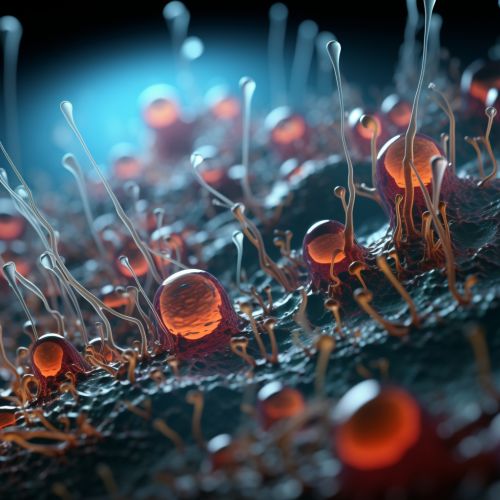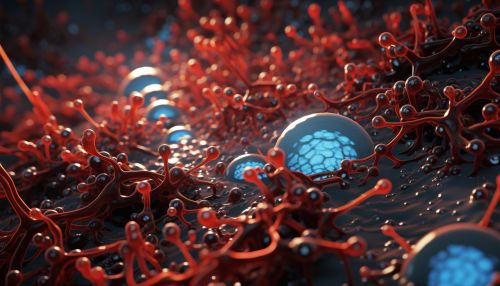The Role of Microbial Siderophores in Iron Acquisition
Introduction
Microbial siderophores are low molecular weight, high-affinity iron chelating compounds produced by microorganisms under iron-limited conditions. They play a crucial role in the survival and growth of these organisms by facilitating the acquisition of iron, a vital nutrient. This article delves into the role of microbial siderophores in iron acquisition, their classification, biosynthesis, and their potential applications in various fields.
Iron and its Importance
Iron is an essential nutrient for almost all living organisms, including microorganisms. It serves as a cofactor for many enzymes involved in vital biological processes such as respiration, DNA synthesis, and metabolism read more. However, iron is not readily available in the environment due to its propensity to form insoluble hydroxides in aerobic and neutral pH conditions. This scarcity of bioavailable iron poses a significant challenge to microorganisms, leading to the evolution of sophisticated iron acquisition strategies, one of which involves the production of siderophores.


Classification of Siderophores
Siderophores are classified based on their chemical structure into three main groups: catecholates, hydroxamates, and carboxylates. Each group has distinct iron-binding properties and mechanisms of action, which are further explored in their respective sections.
Catecholates
Catecholates are the most common type of siderophores and are characterized by their catechol (1,2-dihydroxybenzene) iron-binding group. Enterobactin, produced by Escherichia coli, is a well-studied example of a catecholate siderophore read more.
Hydroxamates
Hydroxamate siderophores contain hydroxamic acid as the iron-binding group. Ferrichrome, produced by Ustilago sphaerogena and several other fungi, is a representative example of this group read more.
Carboxylates
Carboxylate siderophores, such as staphyloferrin A produced by Staphylococcus aureus, utilize carboxylate groups to chelate iron read more.
Biosynthesis of Siderophores
The biosynthesis of siderophores is a complex process that involves multiple enzymatic reactions. It is typically regulated by the intracellular iron concentration, with siderophore production being upregulated under iron-deficient conditions.
Biosynthesis of Catecholates
The biosynthesis of catecholate siderophores, such as enterobactin, involves the condensation of chorismic acid to form 2,3-dihydroxybenzoic acid (DHB), the catechol precursor. This reaction is catalyzed by the enzyme isochorismate synthase read more.
Biosynthesis of Hydroxamates
The biosynthesis of hydroxamate siderophores, such as ferrichrome, involves the condensation of an amino acid (typically ornithine) with an acyl-CoA (usually malonyl-CoA) to form a hydroxamate precursor. This reaction is catalyzed by a nonribosomal peptide synthetase (NRPS) read more.
Biosynthesis of Carboxylates
The biosynthesis of carboxylate siderophores, such as staphyloferrin A, involves the condensation of citric acid with an amino acid to form a carboxylate precursor. This reaction is catalyzed by a citrate synthase read more.
Iron Acquisition by Siderophores
The primary role of siderophores is to scavenge iron from the environment and deliver it to the microbial cell. This process involves several steps: siderophore secretion, iron chelation, siderophore-iron complex recognition, and iron uptake.
Siderophore Secretion
Microorganisms secrete siderophores into the extracellular environment when the intracellular iron concentration is low. This process is facilitated by specific transport proteins located in the cell membrane read more.
Iron Chelation
Once in the environment, the siderophore binds to iron with high affinity, forming a siderophore-iron complex. This process effectively solubilizes the iron, making it available for uptake by the microorganism.
Siderophore-Iron Complex Recognition
The siderophore-iron complex is recognized by specific receptors on the surface of the microbial cell. These receptors have a high affinity for the complex and are often specific for a particular type of siderophore read more.
Iron Uptake
Upon binding of the siderophore-iron complex, the microorganism initiates the process of iron uptake. This process typically involves the transport of the complex across the cell membrane, followed by the release of iron within the cell. The exact mechanism of iron release varies among different microorganisms and can involve either reduction of the iron or hydrolysis of the siderophore read more.
Applications of Siderophores
Due to their unique properties, siderophores have potential applications in various fields, including medicine, agriculture, and bioremediation.
Medicine
In medicine, siderophores are being explored as potential drug delivery systems for targeting cancer cells. Some pathogens, such as Mycobacterium tuberculosis, produce unique siderophores that could serve as targets for novel antimicrobial therapies read more.
Agriculture
In agriculture, siderophores produced by plant-associated bacteria can enhance plant growth by improving iron nutrition. They can also protect plants from pathogenic microorganisms by sequestering iron, thereby limiting its availability to the pathogens read more.
Bioremediation
In bioremediation, siderophores can be used to mobilize and remove toxic metals from contaminated environments. They can also enhance the bioavailability of essential nutrients, promoting the growth of beneficial microorganisms read more.
